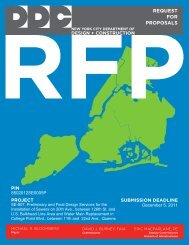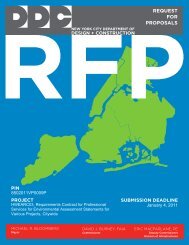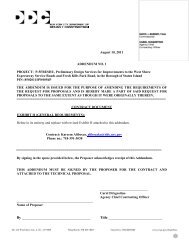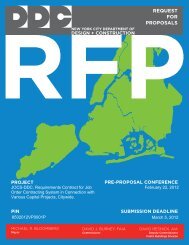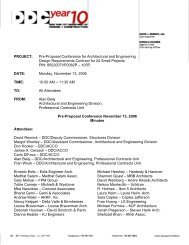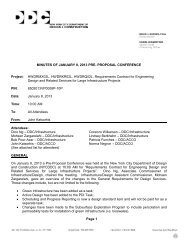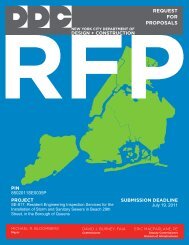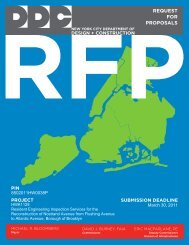requirements contracts for engineering design and related services ...
requirements contracts for engineering design and related services ...
requirements contracts for engineering design and related services ...
Create successful ePaper yourself
Turn your PDF publications into a flip-book with our unique Google optimized e-Paper software.
8. Natural resources (Refer to Chapter 3I of CEQR technical Manual)<br />
The Consultant shall examine the potential impacts of the proposed plan on natural resources including wetl<strong>and</strong>s<br />
<strong>and</strong> upl<strong>and</strong> areas. This ef<strong>for</strong>t shall include detailed tree inventory report <strong>for</strong> the project area <strong>and</strong> an assessment<br />
of tree loss as an environmental impact.<br />
The Consultant shall examine the potential impacts of the proposed plan on existing natural habitats <strong>and</strong> wildlife<br />
within all the wooded areas surrounding the project site.<br />
The Consultant shall identify any permits or other regulatory approvals, which may be required to facilitate the<br />
proposed plan, contact the respective agencies, <strong>and</strong> secure in<strong>for</strong>mation on the applications <strong>and</strong> supporting<br />
materials. These permits may include the following:<br />
<br />
<br />
Wetl<strong>and</strong> Permits (NYSDEC), <strong>and</strong> Army Corps of Engineers.<br />
Authorizations <strong>and</strong> other approvals under the City Planning Commission.<br />
9. Hazardous materials (Refer to Chapter 3J of CEQR technical Manual)<br />
The Consultant shall incorporate the results of the “Preliminary Investigation <strong>and</strong> Assessment of Site<br />
Contamination” with regard to Hazardous Waste within the Project Streets. For those locations, the Consultant<br />
shall conduct a Phase I analysis. The Phase I analysis will be based on historical <strong>and</strong> current l<strong>and</strong> use patterns<br />
along with site surveys. Once locations are identified where hazardous materials may be an issue, the Consultant<br />
shall propose a site-sampling program in order to characterize the potential <strong>for</strong> significant impact. The Consultant<br />
shall propose a sampling program <strong>for</strong> the hazardous materials sampling along with the development of a<br />
conceptual mediation approach.<br />
10. Waterfront revitalization program (Refer to Chapter 3K of CEQR technical Manual)<br />
The Consultant shall verify if the project limits are situated within the <strong>design</strong>ated boundaries of New York City’s<br />
Coastal Zone. If this is the case, the Consultant shall examine the potential impacts of the proposed action <strong>for</strong><br />
their consistency with the City’s Local Waterfront Revitalization Program (LWRP). The WRP consistency<br />
assessment <strong>for</strong>m, which is included in the CEQR manual, shall be utilized <strong>for</strong> this purpose. For a detailed<br />
explanation of the Waterfront Revitalization Program <strong>and</strong> its policies, the Consultant shall obtain the City<br />
Planning’s publication of the New York City Waterfront Revitalization Program.<br />
11. Infrastructure (Refer to Chapter 3L of CEQR technical Manual)<br />
a) The Consultant shall assess the potential environmental impact of the proposed infrastructure improvement<br />
including the installation of new sanitary <strong>and</strong> storm sewers <strong>and</strong> the reconstruction of the Project Streets, on the<br />
existing infrastructure facilities such as the water supply system, sewage treatment <strong>and</strong> storm water systems.<br />
b) The Consultant shall examine the potential impacts of the proposed plan upon public <strong>and</strong> private utilities in the<br />
Project Streets.<br />
c) The Consultant shall assess the potential environmental impacts of any growth-inducing aspects of the proposed<br />
plan including, but not limited to, the construction of new storm water <strong>and</strong> sanitary sewer system, street<br />
reconstruction <strong>and</strong> the impact of change in grade if any. The Engineer shall estimate the additional dem<strong>and</strong> flow<br />
created by the proposal based on current <strong>for</strong>mulas provided by the Department.<br />
d) The Consultant shall examine the potential impacts on City Water Pollution Control Plants (WPCPs) from<br />
additional sanitary flow collected by the sanitary system proposed as part of the project. In accordance with State<br />
Pollution Discharge elimination Permits <strong>and</strong> applicable water quality st<strong>and</strong>ards, the potential effects of the greater<br />
sanitary flow on water quality of receiving bodies should be analyzed.<br />
12. Solid Waste <strong>and</strong> sanitation <strong>services</strong> (Refer to Chapter 3M of CEQR technical Manual)<br />
The Consultant shall examine the potential impacts of the proposed plan upon solid waste generation <strong>and</strong><br />
sanitation <strong>services</strong>.<br />
13. Traffic <strong>and</strong> Parking (Refer to Chapter 3O of CEQR technical Manual)<br />
Traffic Study:<br />
NYC Department of Design <strong>and</strong> Construction<br />
Infrastructure, October 2012<br />
GR-80




